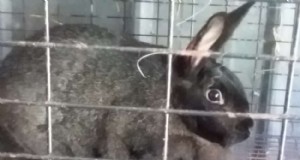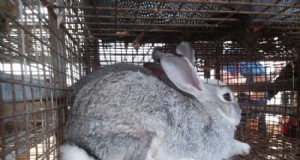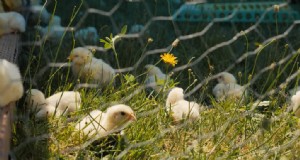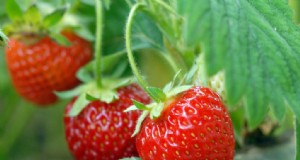Aprender a criar cerdos para carne es una excelente opción para cualquier granja o granja que desee volverse más autosuficiente. Pero elegir la raza y adaptar el cuidado requiere un poco de conocimiento. Siga leyendo para conocer 12 consejos para criar cerdos para carne.
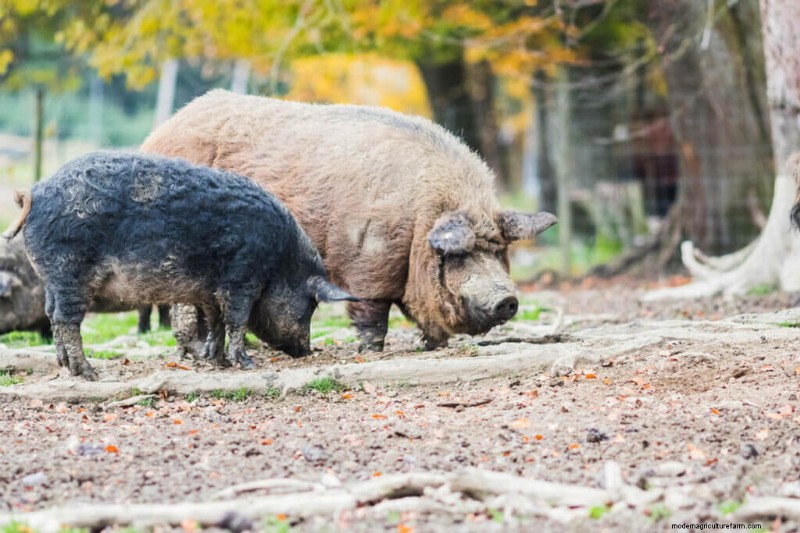
Esta publicación fue escrita y publicada originalmente en 2015 por Amy de Autumn Creek Ranch y desde entonces se actualizó para incluir mi entrevista con "Pork" Rhyne Cureton para obtener aún más información. ¡Disfrútalo!
En podcasts anteriores, hablé de cómo crié cerdos de Guinea americanos y por qué elegimos esa raza específica. Y en otro podcast discutí si pensamos o no que valía la pena criar cerdos de Guinea para obtener carne , incluso si los volveremos a plantear o no.
El invitado del podcast de hoy (Pioneering Today Podcast episodio n.º 331) es "Pork" Rhyne y tuve la suerte de haberlo conocido en la Conferencia Homesteader's of America. . ¡No podía esperar para tenerlo en el podcast para hablar sobre todo lo relacionado con los cerdos!
“Pork” Rhyne trabaja como educador agrícola internacional y experto en mercadeo de carne de nicho. Ha dedicado su vida a capacitar y educar a agricultores experimentados y principiantes sobre negocios y mercadeo. (¡Lea hasta el final de esta publicación dónde puede encontrar carne de cerdo en línea!)
Si no está en un punto en el que esté listo para criar su propia carne, es decir, cerdo, ya que ese es el tema del día, quiero recomendarle Butcher Box .
Butcher Box es patrocinador del Pioneering Today Podcast y tienen un evento especial desde ahora hasta el 20 de enero de 2022 llamado New Year's Bundle. ¡En este paquete, solo para suscriptores primerizos, obtendrá 7 libras de carne GRATIS en su primera caja! Vaya a butcherbox.com/pioneeringtoday para registrarse!
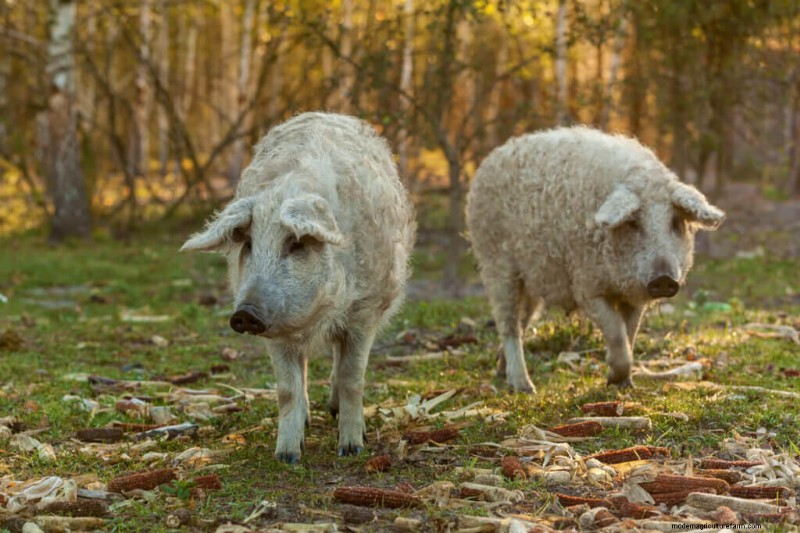
Por qué me encanta criar cerdos
Realmente creo que los cerdos son uno de los animales más fáciles de criar en una granja. Maduran bastante más rápido que una vaca de carne y rinden mucha más carne (y manteca de cerdo) que un pollo o un conejo (y francamente carne de cerdo desmenuzada, tocino fresco, manteca de cerdo procesada en casa , y jamones salados son simplemente increíbles!!!).
Otros animales para criar
Antes de comenzar a criar cerdos, para obtener más información sobre cómo criar su propia carne, asegúrese de consultar esta publicación sobre planificación de su ganado y crianza de suficiente carne para la alimentación de un año. . Además de lo siguiente para otras publicaciones específicas de animales:
- R criando gallinas ponedoras de huevos en el patio trasero
- Cría de aves de carne en el patio trasero
- Cómo criar una vaca lechera
- Cría de conejos de carne
- Cría de ovejas (para fibra)
- Guía para criar cabras
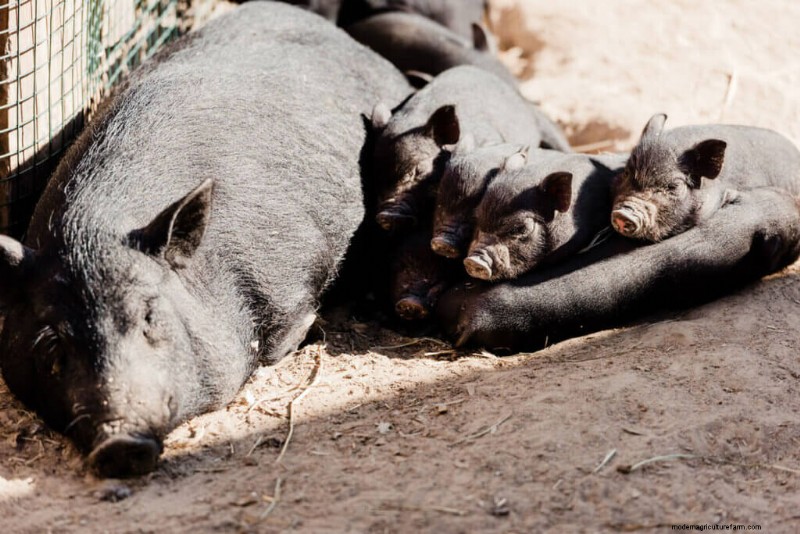
12 consejos para criar cerdos
Entonces, ¿quizás has pensado en criar un cerdo (o dos) y no sabes por dónde empezar? Aquí hay algunos consejos y sugerencias que espero te ayuden en tu camino para criar tu propia deliciosa carne de cerdo. .
Comprar lechones
Para alguien interesado en criar unos cuantos cerdos al año para obtener carne, es más fácil comprar lechones que criar su propio ganado reproductor.
Los lechones varían en precio debido a la ubicación, la época del año (son más caros en primavera cuando los niños en 4-H están tratando de encontrarlos) y por raza.
En el momento original de la redacción de esta publicación (2015), los lechones se vendían por alrededor de $ 125 cada uno, pero se podían encontrar a un precio tan bajo como $ 75, dependiendo de la demanda del mercado. (Es probable que los precios sean más altos ahora.)
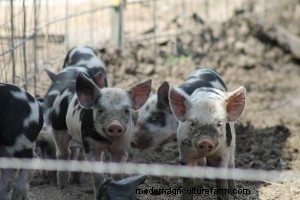
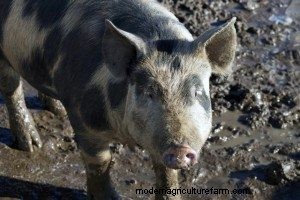
La edad importa
El estándar de la industria para la venta de cerditos es de 6 semanas de edad. Sin embargo, vendemos nuestros lechones a las 8 semanas de edad porque descubrimos que los lechones a los que se les permite permanecer con la cerda esas dos semanas adicionales tienen sistemas inmunológicos más fuertes y no necesitan ser alimentados con alimento de inicio.
Por supuesto, eso significa que tenemos que alimentar a la cerda extra para mantener su condición, pero creemos que los lechones más sanos valen la pena.
Si puede encontrar lechones a los que se les ha permitido amamantar un poco más, vale la pena el costo adicional, ya que le ahorrará tanto en su factura de alimentación como en posibles problemas de salud para el lechón.
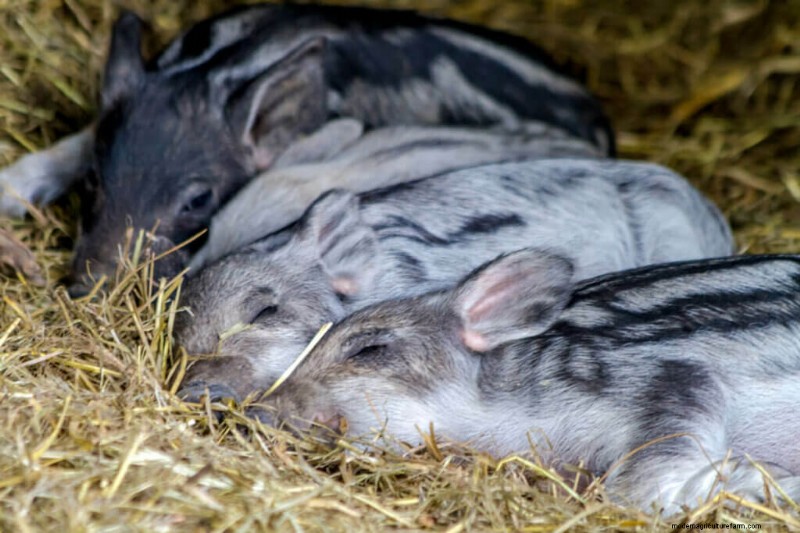
Consideraciones de espacio
Antes de traer lechones a casa, debe tener un corral y algún tipo de refugio para ellos. Hablaré más sobre esgrima en un minuto, pero hay algunas consideraciones a tener en cuenta al planificar su corral.
Si el corral es pequeño, los lechones crecerán más rápido porque no tendrán tanto espacio para hacer ejercicio y el suelo se puede destruir mucho.
Además, en un área más pequeña, los parásitos tienen más posibilidades de crecer. Finalmente, un corral pequeño en la primavera cuando el clima es húmedo puede resultar en un gran pozo de lodo.
Sin embargo, como comenta Pork Rhyne en la entrevista del podcast, esto no significa que deba tener espacio para criar o pastar a sus cerdos. Criar sus propios cerdos es un gran paso adelante en comparación con la compra de productos porcinos criados comercialmente, incluso si no tiene las condiciones de vida ideales para esos cerdos.
Preferimos usar áreas rotativas en los meses más cálidos y áreas realmente grandes más cerca de la casa en los meses más fríos (de hecho, ponemos cerdos en nuestras áreas de jardín durante el invierno para que puedan cultivarlas y fertilizarlas en preparación para la siembra de primavera).
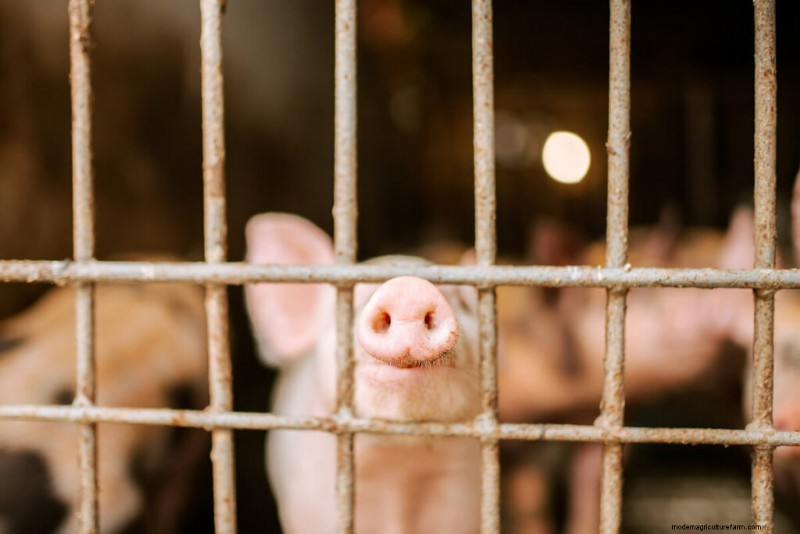
Cercado
Cuando los lechones son jóvenes, es mejor que estén en un panel de ganado, un panel de cerdos o un corral de paletas.
Las redes eléctricas, las cuerdas o los cables no funcionan bien con lechones pequeños porque pueden salir (hablado de mucha experiencia y de un lechón que se fue durante dos semanas en los bosques circundantes de nuestra propiedad).
Mantenemos a los lechones en un pequeño corral de paneles para ganado con alambre eléctrico en la parte inferior hasta que tienen alrededor de 12-15 semanas y luego los trasladamos a corrales hechos con hilo o alambre eléctrico hasta que alcanzan el peso de sacrificio.
Por lo general, a las 12-15 semanas están entrenados para la electricidad y son lo suficientemente grandes como para no meterse con eso. Sin embargo, es bueno tener una vía de salida o una puerta que no sea eléctrica. Los cerdos pueden estar tan bien entrenados para cercas eléctricas que cuando queremos moverlos no se acercarán a un lugar donde SOLAMENTE había cercas eléctricas.
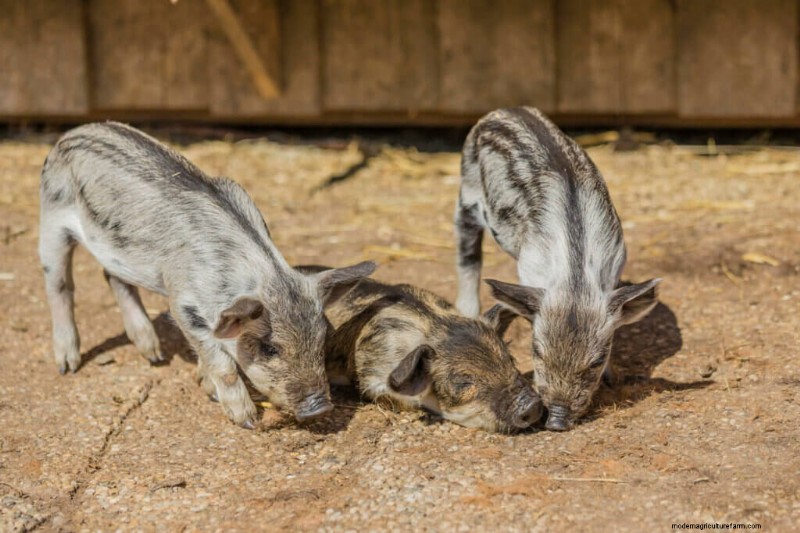
Alimentación de cerdos
Hay muchas formas posibles de alimentar a tu cerdo. Lo más fácil es comprar un criador de cerdos comercial. Los cerdos crecen más rápido con este tipo de ración. Desafortunadamente, la mayoría de las fórmulas comerciales para criadores de cerdos contienen maíz y soya, que probablemente sea OGM.
Muchos alimentos comerciales también contienen medicamentos que pueden o no ser necesarios para su animal en particular.
Como no nos gusta dar medicamentos innecesariamente a nuestros animales, otra opción es hacer su propio alimento a partir de una fuente de granos y proteínas o encontrar un alimento natural prefabricado en su área.
Esto es lo que Pork Rhyne tiene que decir sobre la alimentación de los cerdos... Hay tanta controversia sobre qué alimentar a los cerdos, desde ir a la panadería local y alimentar a los cerdos con pan del día anterior, hasta comprar solo el mejor alimento orgánico sin OMG.
Hay tantas personas que recién comienzan a criar cerdos que en realidad no saben cómo es un cerdo sano. Por lo tanto, recomienda pasar tiempo con alguien más que críe cerdos para aprender y acostumbrarse a cuánto deben comer los cerdos, cómo varía su apetito según las estaciones y cómo se ve un cerdo saludable.
A los granjeros nos encanta la ruta alternativa, cada vez que podamos hacer bricolaje o tengamos una forma alternativa de hacer algo, ¡lo aprovecharemos! Creo que está en nuestra naturaleza. Pero antes de sumergirse en la elaboración de su propio alimento para cerdos, es importante comprender los componentes del alimento para saber cómo alimentar a un cerdo a fin de obtener un producto con una relación grasa:carne con la que esté satisfecho cuando llegue el momento de la carnicería.
- Carbohidratos – fuente de energía, a menudo maíz o grano
- Fuente de proteínas – habas de soja, habas, etc.
- Fibra/Minerales/etc – estos conformarán el resto del alimento para ayudar a mantener saludables a los cerdos
Una vez que tenga los componentes básicos del alimento, también es importante conocer su raza específica porque cada raza tendrá diferentes necesidades de carbohidratos y proteínas.
Cuando se trata de cerdos de Guinea americanos, son propensos a la obesidad, por lo que necesitan una dieta baja en carbohidratos para evitar engordar demasiado a los cerdos.
Pork Rhyne tenía un amigo que estaba realmente decepcionado con la proporción de carne y grasa que obtuvo después de sacrificar a sus cerdos, pero resultó que los estaba alimentando con un 16 % de proteína cruda durante toda su vida en lugar de reducir la proteína antes de sacrificarlos. .
Por lo general, alrededor de 2 a 3 meses antes del sacrificio, Pork Rhyne recomienda reducir la cantidad de proteína hasta un 12 a 14 % y aumentar la cantidad de carbohidratos para convertir esa energía en grasa.
Como dije anteriormente, todo esto varía entre razas y es diferente para herefords, razas heredadas, razas comerciales, etc.
Además del alimento prefabricado, a los cerdos les encanta todo tipo de productos. Incluso puede cultivar cultivos específicos para sus cerdos, como mangels, nabos forrajeros, remolachas y calabazas.
En nuestra granja, alimentamos una combinación de cebada y guisantes de origen local con minerales porcinos añadidos. Nuestros cerdos también obtienen mucha leche fresca, restos de comida, manzanas locales y calabazas.
Por favor, no alimente a sus cerdos con sobras de panadería y similares y espere un cerdo saludable con una carne de gran sabor. Comes lo que come tu cerdo, así que la calidad es importante.
Otro ejemplo de formas de alimentar a los cerdos es que Pork Rhyne tiene un amigo que fue a Chipotle (la cadena de restaurantes de comida rápida) y recogió frijoles que no se vendían a los consumidores para alimentar a sus cerdos.
Estoy a favor de ser ingenioso! Solo asegúrese de que la comida que está recibiendo no sea posconsumo (lo que significa que no se sirvió primero a un cliente y luego se tiró a la basura porque eso propagaría enfermedades a sus cerdos) y asegúrese de que no haya carne de cerdo en el producto.
Una cosa que me encanta hacer es obtener mi feed lo más localmente posible. Tenemos un granero que está a aproximadamente una hora de distancia que tiene una postura sin OGM y también trata de obtener su grano lo más localmente posible. Para obtener consejos para ahorrar dinero al comprar en su granero local, consulte Abastecerse de alimentos para animales (+ cuánto alimentar a los animales).
También sepa, si está alimentando a sus cerdos con grano gastado (como el grano de cervecería que puede obtener de una cervecería), aproximadamente el 80% es agua. Por ejemplo, si ese grano estuviera seco, contendría alrededor de un 29 % de proteína, mientras que una vez que el grano está húmedo (o gastado), solo contiene un 7,7 % de proteína cruda.
El grano gastado también se enmohece muy rápidamente, por lo que Pork Rhyne lo recomienda como complemento de la dieta, no como fuente principal.
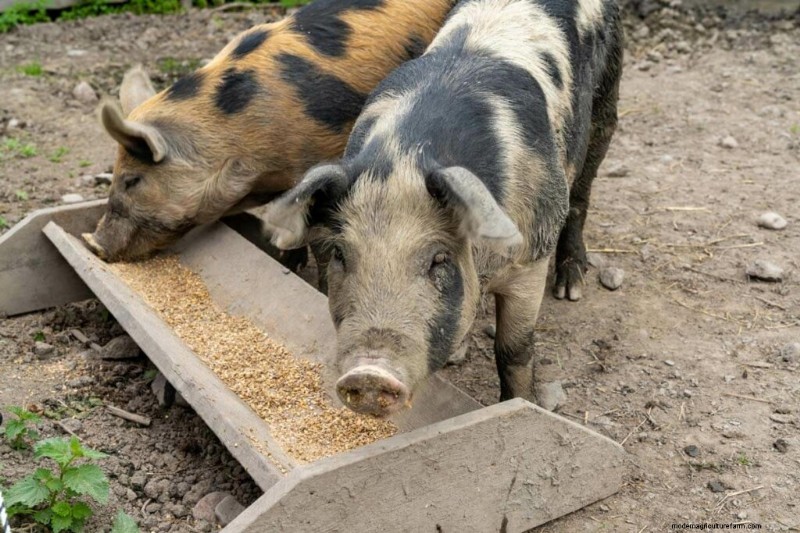
Demanda frente a alimentación medida
Otra cosa a considerar al criar cerdos es si instalar un comedero automático y dejar que los cerdos coman cuando quieran o alimentarlos con una cantidad determinada cada día.
Hay pros y contras para ambos. La alimentación a demanda reduce la carga de trabajo diaria excepto el día en que hay que llenar el comedero de los cerdos. Además, si los cerdos siempre tienen comida disponible, será menos probable que arraiguen tanto y, por lo tanto, su suelo se mantendrá en mejor forma. Los cerdos que se alimentan a demanda también tienden a crecer más rápido, por lo que su tiempo hasta la madurez es menor.
El problema con la alimentación a demanda es que los cerdos pueden comer MUCHA comida y esto puede ser costoso, especialmente a medida que los cerdos crecen.
Hemos descubierto que si solo está criando uno o dos cerdos, la alimentación a demanda es el camino a seguir. Cuando estás recaudando 10 o más es cuando puede volverse un costo prohibitivo.
Le damos a cada uno de nuestros lechones 5 libras de su mezcla de granos cada día. Además de esto, obtienen leche, sobras de la mesa y productos agrícolas.
Esto nos permite tener cerdos con peso de mercado alrededor de los 8 meses.
Medicamentos y Desparasitantes (DIY De-Wormer)
No soy muy fan de los antiparasitarios químicos por las mutaciones y resistencias que crean.
En nuestra granja, hemos encontrado que el ajo es un antiparasitario mucho más efectivo de todos modos.
Agregamos aproximadamente 1 libra de gránulos de ajo a una tonelada de alimento.
Además, el aceite de orégano también es excelente para combatir parásitos e infecciones.
Finalmente, mantenemos el aceite esencial de geranio a mano para el sangrado (los cerdos pueden pelearse) y el aceite de árbol de té para cortes y raspaduras.
¿Castrar o no?
La castración de los cerdos es un tema controvertido. Hay muchos que encuentran la práctica cruel e innecesaria, pero otros dicen que debe hacerse para prevenir el olor a verraco.
Si está criando dos cerdos machos, deberá determinar si desea realizar este procedimiento.
Sin embargo, cuando estás criando lechones del sexo opuesto, es aconsejable seguir adelante y castrar. Cuando empezamos a criar lechones, nos dijeron que no empezarían a reproducirse hasta los 9 meses. Como sacrificamos a los 8 meses, no pensamos que necesitáramos castrar.
Mal consejo y terminamos con cerdos de mercado preñados. Ahora castramos a todos los lechones machos criados para carne. Hemos encontrado Remedio de rescate de Bach muy útil en el proceso:mantiene tranquilos tanto a los cerdos como a la persona que realiza la castración.
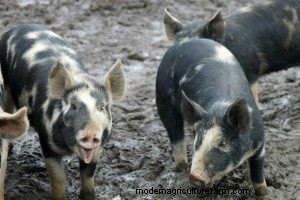
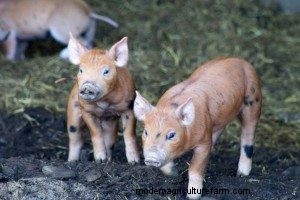
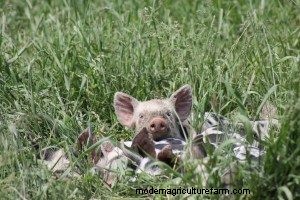
Las razas importan
Las diferentes razas de cerdos tienen diferentes cualidades, incluidas diferencias en tamaño, calidad de la carne y temperamento.
Estas son cosas que querrá investigar al elegir sus lechones antes de llevarlos a casa.
Criamos razas tradicionales de cerdos (Gloucester Old Spot, American Guinea Hog, Tamworth) debido a su temperamento dócil y amigable y excelente calidad de carne.
El cerdo de Guinea americano es una raza de cerdo mucho más pequeña y no producirá un peso de canal convencional, pero debido a su fácil manejo y carne de calidad de chef, es una compensación que estamos dispuestos a hacer.
Los primeros cerdos de Pork Rhyne eran en realidad una raza tradicional llamada "negros grandes" y "bamboleo rojo". También crió algunos cruces y cerdos comerciales.
Hace 200 años, los cerdos no recibían las dietas que reciben ahora. Eran animales de bajo consumo, al igual que las gallinas, donde se les alimentaba con las sobras de la cocina o el jardín, en libertad y rumiando, etc.
Durante muchos años, los cerdos fueron “a prueba de fallas”. Si un cultivo tuvo una mala cosecha un año, las familias siempre tendrían cerdos para vender para llegar a fin de mes.
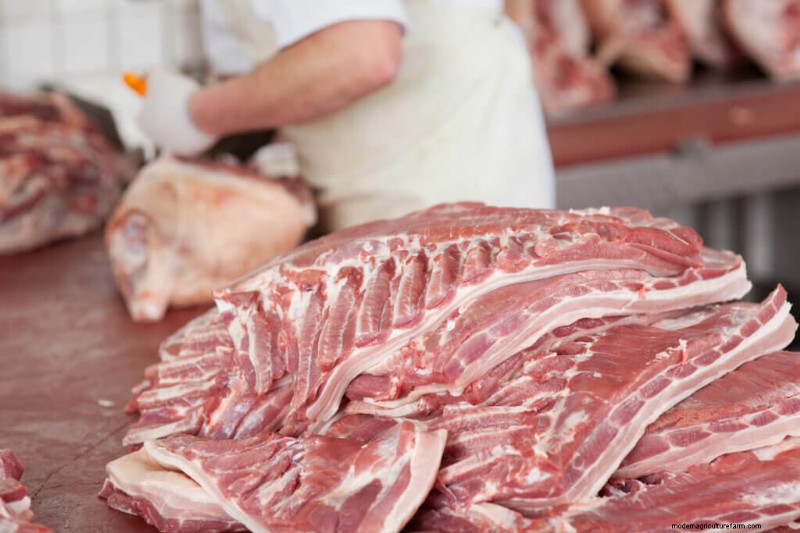
Peso de carnicero y peso colgante
La mayoría de los cerdos tradicionales se sacrifican cuando pesan entre 180 y 250 libras vivos. Esto dará como resultado un peso colgante (carne y huesos menos la cabeza, los pies y los órganos) que oscila entre 160 y 225 libras.
La cantidad de carne que termine en su congelador depende totalmente de los tipos de cortes que elija durante el procesamiento.
Es importante comprender que los cerdos de raza tradicional crecen más lentamente que los cerdos comerciales.
Por lo general, las razas heredadas tardan aproximadamente 8 meses en alcanzar aproximadamente 280 libras. Los cerdos de manteca tardan hasta un año o año y medio en alcanzar el peso de matadero (que a veces, dependiendo de la raza, no será tan pesado).
Pero los cerdos comerciales alcanzan las 280-300 libras en solo 6 meses. Entonces puede ver por qué los cerdos comerciales se han vuelto más populares entre las grandes granjas.
Para obtener información más exacta sobre cada raza individual, descargue este cuadro de la Organización para la Conservación del Ganado .
Sepa para qué quiere criar carne de cerdo antes de elegir su raza. Muchas razas son mucho mejores para cosas como salchichas, salchichas, embutidos, etc. mientras que otras razas te darán jamones, chuletas de cerdo y asados grandes.
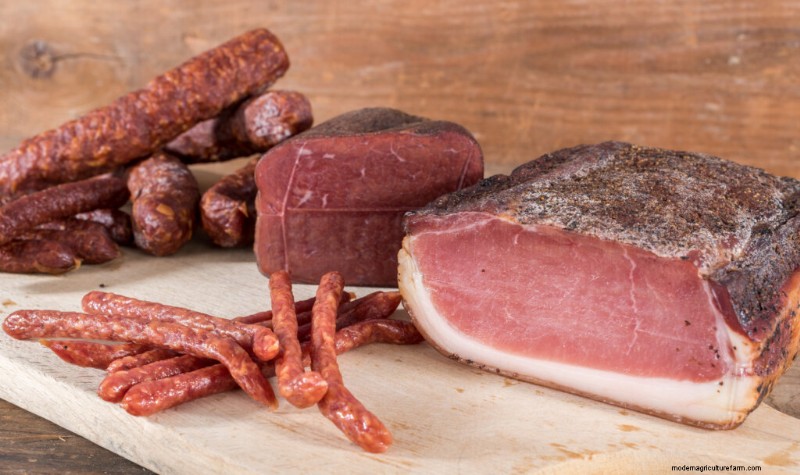
¿Debería contratar a un carnicero?
Hemos sacrificado muchos cerdos en nuestra granja. Una vez que aprendes a hacerlo no es tan difícil, pero la primera vez puede ser un poco intimidante.
Todo el proceso tarda unos 3 días. El primer día es matar y colgar, el segundo es desollar y cortar los trozos, el tercero suele ser el procesamiento de salchichas.
Una desventaja de matarte a ti mismo es que, a menos que sepas cómo curar tocino y jamón no acabarás con esos cortes (tendrás jamón fresco que está buenísimo pero no como el jamón curado tradicional).
Los beneficios de matarse a sí mismo son el conocimiento y el ahorro de costos. Tradicionalmente, sacrificar un cerdo cuesta entre $150 y $250, según el procesamiento y el curado.
El sabor es superior
Al criar sus propios cerdos, usted controla lo que comen, lo que lo convierte en un producto más saludable para su familia.
Además, criar cerdos es muy divertido y me encanta ver sus payasadas. Sin embargo, creo que la mejor razón para criar carne de cerdo es el sabor. Una vez que lo pruebes nunca más querrás cerdo de supermercado.
Más sobre Amy

Amy es esposa y madre de 18 hijos. Además de criar y educar en el hogar a su mega familia, también administran una pequeña granja familiar, a la que llaman cariñosamente "Rancho Autumn Creek .” Les encanta el trabajo de Joel Salatin (¡yo también!) y han modelado gran parte de lo que hacen con su ejemplo.
¿Tiene alguna pregunta sobre la crianza de cerdos? Puede enviar un correo electrónico a Amy a [email protected]
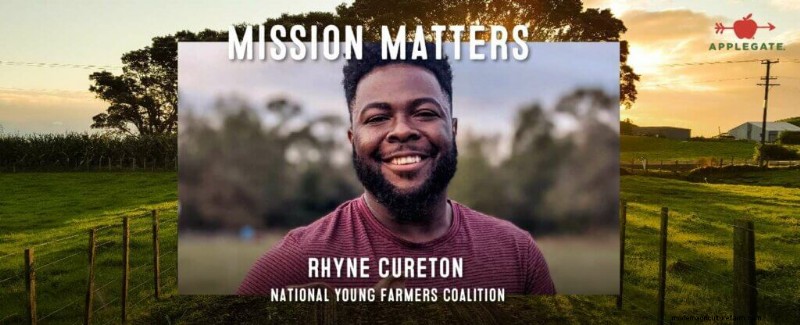
Más acerca de “Pork” Rhyne Cureton
Asegúrese de escuchar el podcast (a partir del minuto 41) para enterarse del trabajo de Pork Rhyne en países del tercer mundo a través de la empresa EATBETA - Evangelizing Africa Through Business Empowerement in a Transformation of Agriculture.
- Pork Rhyne TV en YouTube
- Instagram
- Facebook
- Granjeros de América
- Correo electrónico:[email protected]
TranscripciónCorreo electrónicoDescargarNueva pestaña
Melissa K. Norris: Hola, pioneros. Bienvenidos al episodio número 331 del Pioneering Today Podcast... Hoy vamos a estar hablando de uno de mis temas favoritos. Siento que todos son mis favoritos, pero este definitivamente es alto, y se trata de criar cerdos. Hemos cubierto la crianza de cerdos antes en diferentes episodios del podcast. Hemos hablado sobre la raza Heritage American Guinea Hog conocida... Estoy usando comillas, aunque no se pueden ver... algo así como, AKA, "el cerdo del granjero". Mi experiencia, en las notas del programa, vincularemos a esos si desea ver algunos de esos episodios anteriores, mi experiencia con ellos.
En el episodio de hoy, estoy muy emocionada, porque vamos a sumergirnos en los cerdos, pero vamos a hablar sobre muchos consejos comunes o que se ven a menudo cuando se trata de criar cerdos, específicamente sobre la alimentación. lo que está alimentando a sus cerdos, el manejo del pasto y algunas otras cosas por el estilo que a menudo son inexactas, o no necesariamente sirven mejor al cerdo y al granjero. En el episodio de hoy, vamos a sumergirnos con el invitado de hoy. Estoy muy emocionado. Escucharán, tan pronto como comencemos la entrevista, cómo los conocí, un poco de la historia de fondo. Os voy a avisar que, cuando os lo presente, no subáis demasiado el volumen. Es solo por el primer minuto. Entenderás por qué digo eso cuando llegues allí. Todo es muy divertido, y creo que realmente lo disfrutarás y su entusiasmo sobre el tema.
Antes de llegar allí, el episodio de hoy está patrocinado por ButcherBox, lo cual es muy apropiado, ya que estamos hablando de carne. Si aún no ha llegado a un punto en el viaje de su hogar, o no tiene un granjero local donde pueda comprar su carne, entonces ButcherBox hace que sea fácil obtener carne de alta calidad y criada humanamente en la que pueda confiar. Entregan carne de res 100% alimentada con pasto y terminada con pasto, pollo orgánico de corral y cerdo criado en el patrimonio, junto con mariscos capturados en la naturaleza, directamente a su puerta. De hecho, hemos probado todo lo anterior. Siempre ha llegado y ha estado completamente congelado, incluso cuando era al final del día y al final de la ruta rural en la que nos encontramos para un repartidor. No hemos tenido ninguno que no nos haya gustado. Me ha impresionado mucho la calidad, el sabor, la forma en que se cocina. Todo por encima de lo anterior, si no es algo que puedas plantear tú mismo.
Una de las mejores cosas es que, debido a que usted es un oyente de Pioneering Today Podcast, hay un especial hasta el 20 de enero. Es el Paquete de Año Nuevo. Puede obtener siete libras de carne gratis en su primera caja cuando se registre como nuevo cliente en ButcherBox. Para enganchar eso, vaya a ButcherBox.com/PioneeringToday. Eso es ButcherBox.com/PioneeringToday. Obtenga sus siete libras de carne gratis en su primera caja. Muchas gracias, ButcherBox, por patrocinar el podcast Pioneering Today.
Si eres un nuevo oyente del podcast, bienvenido. Un oyente desde hace mucho tiempo, choca los cinco. Bienvenido de vuelta mi amigo. Mi nombre es Melissa K. Norris. Soy un granjero de quinta generación, y ayudo a miles de personas, cada mes, a aprender cómo vivir una vida casera y hecha a mano utilizando una agricultura moderna y sencilla, sin importar dónde se encuentre. El invitado de hoy se conoce como Pork Rhyne. Su verdadero nombre es en realidad Rhyne Cureton. Creo que así es como lo dices. Es conocido como un evangelista del cerdo en todo el país, e incluso en el extranjero en el este de África, de lo que hablaremos un poco. Me parece muy interesante y fascinante. Trabaja como educador agrícola internacional y experto en mercadeo de carne de nicho. Durante más de cinco años, Rhyne ha dedicado su vida a capacitar y educar a agricultores experimentados y principiantes, principalmente en producción, negocios y mercadeo de ganado a pequeña escala. Definitivamente vamos a hablar sobre criar cerdos en un entorno de granja de ganado más pequeño, así que estoy muy, muy emocionado de darle la bienvenida al podcast y hablar sobre esto.
Para obtener enlaces a algunos de los episodios anteriores que menciono y algunas de las cosas de las que hablaremos, puede obtener todo eso en MelissaKNorris.com/331. Ese es solo el número 331, porque este es el episodio 331. De nuevo, MelissaKNorris.com/331. Vayamos al episodio de hoy.
Bueno, estoy súper emocionada por este episodio. Voy a advertirles a todos. Va a ser mucha energía, porque muy pocas personas que conozco tienden a tener el nivel de energía que yo tengo. Sin más preámbulos, Pork Rhyne, bienvenido al podcast Pioneering Today.
"Cerdo" Rhyne Cureton: Estoy emocionado. Estoy emocionado. Trajiste a la persona equivocada aquí.
Melissa K. Norris: No pienso en el mal. Estoy pensando en lo correcto. Me encantó tu energía en HOA, así que me alegré mucho. Estuvimos conversando un poco antes de comenzar a grabar, muchachos, y básicamente le envié una invitación al podcast que no le dio la oportunidad de retirarse o decir que no. Básicamente dije:"Oye, ¿cuál es la fecha y la hora en la que quieres salir?". Estoy muy contento de que tomó mi fuerte invitación armada y aceptó. Estoy muy emocionado. Tengo la sensación de que vamos a cubrir mucho en este episodio, así que vamos a sumergirnos directamente en él.
Una de las cosas, cuando estábamos chateando, que realmente [inaudible 00:06:06]. Dijiste que ves muchas cosas que se ofrecen en línea. Asumiré, porque me gusta asumir lo mejor de todos, que muchas de estas cosas se ofrecen con buenas intenciones, pero se ven muchas cosas cuando se trata de criar cerdos en línea, o con frecuencia, debería decir , que causa problemas o puede ser problemático. Me encantaría que profundizaras un poco más en eso.
"Cerdo" Rhyne Cureton: Oh sí. Oh sí. Entremos en esto. Antecedentes sobre mí. Yo solía cultivar. Volverá a la agricultura. Trabajó con el National Pork Board en Pork Checkoff. Razas de herencia criadas cuando cultivé. Volverá a las razas patrimoniales. He estado enseñando a la gente a criar cerdos, tanto en todo el país como en el extranjero, durante los últimos cinco años. Estoy usando esa experiencia para hablar de esto.
Una de las cosas que he notado con las personas que se están dedicando a la cría de cerdos, y nunca antes habían criado cerdos en toda su vida, lo más probable es que ni siquiera provengan de un entorno agrícola, es que hay muchos problemas. temas en términos de alimentación, en términos de prácticas de la tierra, en términos de bienestar animal, y me atrevo a decir legalismo, cuando nos metemos en grupos de homesteading, grupos que son alternativos a los estándares y modelos convencionales con la industria porcina. He visto mucha desinformación en términos de cuánto debes alimentar a tu cerdo.
Oh hombre. Melissa, hay mucha información contradictoria. Debería volverte loco, sinceramente. Lo siento por las personas que se están dedicando a la crianza de cerdos y no tienen idea de por dónde empezar, o van a una publicación de blog y luego van a un par de videos de YouTube. Están recibiendo información completamente diferente. No hay realmente ninguna consistencia o continuidad. La mayoría de la gente está buscando una fórmula, como "¿Cuál es una fórmula que puedo usar y con la que puedo tener éxito?" El único mito que quiero disipar, uno de los mitos más grandes que he visto, es que no existe una fórmula para esto.
Melissa K. Norris: Amén. Amén.
"Cerdo" Rhyne Cureton: No hay absolutamente ninguna fórmula. Ahora, cuando te metes en la agricultura convencional comercial, en realidad hay una fórmula. Si lo sigues, te irá bien. Para las razas heredadas, para las personas que crían cerdos al aire libre, en pastos o en establos, es muy diferente. No hay esa consistencia porque, A, tienes los elementos que afectan cuánto comerá un cerdo. Por ejemplo, cuando hace más calor, a los cerdos no les gusta comer cuando tienen calor. Simplemente no lo hacen. No lo hacen ni un poco. Luego, su capacidad para ganar masa muscular y grasa disminuye porque no comen tanto. ¿Derecha? Cuando hace frío, comen mucho más, porque están tratando de usar granos, o lo que sea que les estés dando de comer, como una forma de generar calor para que se mantengan calientes. Realmente no hay consistencia porque no estamos criando cerdos en ambientes de ratas de laboratorio. Simplemente no lo somos.
Una cosa que realmente promuevo es tener un ojo de agricultor. Lo que quiero decir con eso no es solo alimentar a un animal, darle agua y refugio. No solo esas cosas, sino todos los contenidos intermedios. ¿Derecha? Lo que realmente requiere son habilidades de observación. Vas a cometer errores. Bueno, no tú, Melissa, sino el público. [diafonía 00:09:44]
Melissa K. Norris: Oh, no. Cometo muchos errores, pero gracias por eso.
"Cerdo" Rhyne Cureton: Tratando de no tirarte debajo del autobús... Si estás cultivando y estás empezando, vas a cometer muchos errores, en términos de alimentación, en términos de alojamiento, en términos de bienestar animal, y eso está bien Hay mucha información contradictoria por ahí, y mucha gente que está haciendo videos o blogs que no tienen, necesariamente, la experiencia que tengo yo, o la experiencia que tendría un criador de cerdos convencional. Mucha gente está aprendiendo de gente que acaba de empezar. Hay muchas personas que están aprendiendo cómo criar cerdos de personas que han estado criando cerdos durante un año o menos. ¿Derecha? Las personas que han estado criando cerdos, e incluso al aire libre, durante varios años, cinco años, 10 años, 20 años, no están en línea porque están demasiado ocupados ganando dinero criando cerdos. Eso puede ser problemático en muchos casos.
Una cosa que quiero decir es que tengas gracia contigo mismo cuando empieces y averigües cosas. Simplemente comprenda que no existe una fórmula, y que esa fórmula cambia con la raza, con el tipo particular de cerdos que obtiene. Incluso dentro de una raza, existen diferentes variaciones de tamaños. Melissa, crías cerdos de Guinea americanos. Hay una gran [inaudible 00:11:01] montando, y hay otras que se hicieron muy pequeñas. La diferencia en el crecimiento puede ser muy drástica entre esos dos tipos diferentes dentro de esa raza. Hay muchos matices en la cría de cerdos.
Una parte de mí, ahora que eventualmente comencé Pork Rhyne TV, es poder hacer que la gente entienda que puedes tener éxito en la crianza de cerdos dentro de tu contexto particular. Lo importante es ser flexible, ser capaz de recibir críticas constructivas y ser capaz de tener habilidades de observación y utilizar esas habilidades de observación con mejores prácticas. He visto mucha gente que lamentablemente termina cayendo en el legalismo. Están diciendo:"Bueno, esta persona cría cerdos de esta manera, así que si no estás criando cerdos de esta manera, entonces no eres un buen granjero". Escucho eso mucho. Escucho a mucha gente, como, "Bueno, si no estás criando a tus cerdos en pastos, entonces no eres un buen granjero". Bueno, creo que casi todo el mundo puede criar cerdos, y creo que podría recibir algunos mensajes de odio por esto. No creo que la producción de pastos para cerdos sea el único camino. ¿Verdad?
Melissa K. Norris: Correcto.
"Cerdo" Rhyne Cureton: He estado en África. Tienen praderas. Tienen sabanas. No tienen pasto. Si tienen pasto, no están poniendo cerdos en él. Están poniendo vacas. Están poniendo cabras, y están poniendo ovejas allí. Los cerdos son lo último que van a poner a pastar. Eso no tiene ningún sentido. Además, tienen depredadores de dos patas. ¿Derecha? No solo tienen los animales salvajes de cuatro patas. Tienen depredadores de dos patas, también conocidos como humanos, que en realidad vienen y roban sus cerdos. No hay red eléctrica cuando hay apagones eléctricos todos los días o un par de veces al día. ¿Derecha? Me gusta mirar, ¿cuál es el contexto? ¿Cuáles son sus recursos limitados? ¿Qué tienes? ¿Cuál es tu experiencia? ¿Cuánto tiempo tienes para hacer esto?
Luego, cuando estoy trabajando con granjeros, simplemente los ayudo a crear su propio plan dentro de sus limitaciones dadas, su manejo del tiempo dado, su estilo de vida dado y la forma en que todavía permite el bienestar animal adecuado. Hay algunas personas que son muy legalistas, dentro de nuestro sector particular de hacienda y agricultura, que terminan atacando realmente a las granjas comerciales. Entonces, el problema que veo es cuando voy a estas granjas familiares. I see animals in more deplorable situations than when I see when I go into a commercial hog situation, or even when I see when I go to East Africa. Explain that to me. How can one person be bashing and sense some, yet not have proper animal welfare? That makes absolutely no sense, but this is something that I see a lot in common with people who want to have a formula for how they be successful, or want to be in legalism on there's only one way of doing something right. I truly don't believe that. I think there are multiple ways of having healthy hogs, and even a healthy family with those hogs.
Melissa K Norris: Sí. I completely agree with you on so many things, especially with the context in looking with where you at and working within the resources, and also understanding climate, as well as workload. Until very recently, actually, I worked a day job where I was commuting. I was a pharmacy tech and was commuting 18 miles one way. My husband still works off of our homestead and farm, so he still has a day job. For us, we do have our pigs on pasture, but we don't rotate them. They're not on fresh grass every day, simply because when you leave at 5:00 AM in the morning, and it's dark, and you're not getting home until sometimes 6:00 at night, if not later, there's only so many hours in the day. I think, just like you said, that that legalistic part ... Yes, no matter what method you choose to raise your pigs, you're going to want to make sure that you are raising them as ethically and as humanely as possible, but there's more than one way to do that.
I'm really happy that you're talking about that, and also looking at your climate, because, from our experience, the American Guinea Hogs that we had, it overall was a very pleasant experience that I have. Were They Worth It?: a different episode you guys can all go and listen to on that in drawing the difference between raising the Hereford versus the American Guinea Hogs. You really need to dig into your climate with the different breeds, as well as expectations.
I wanted to circle back to one of the things, and that is feed. Feed, not only how much, as you said, and definitely your climate, and the time of year, and so many things we're going to determine. The best thing is looking at the animal. Does it look healthy? Does it look underweight? Is it looking too fat, and [inaudible 00:15:45] ... but types of feed, because, as you know, that is also controversial. Who knew homesteading could be so controversial? I swear, every aspect of homesteading I talk about, there's controversy somewhere or another. I'd love to address that, because I know this is a thing where some people are like, "Well, just go. Go to the bakery and get day old bread that they're getting rid of." Then you've got your purists. ¿Derecha? There's all these things. Let's talk about them. Why is that a good idea? Why is that not a good idea? All the things. Let's dive into feeding pigs.
"Pork" Rhyne Cureton: Oh hombre. You mentioned earlier of what does a healthy a pig look like? I think part of the issue is a lot of people who are starting raising pigs doesn't know what a healthy pig looks like.
Melissa K Norris: Yeah.
"Pork" Rhyne Cureton: Or how a healthy pig behaves, so that's part of the reason why I'd say, before you get your pigs, spend some time volunteering on a local farm that has the practices that you want to have, if possible. That's not for everybody. Not everyone has the time or energy. Even if it's just like, "You know what? I'm just going to spend a weekend once a month going to a farm. They might be a couple of miles away, several miles away, but I want to learn how they're doing things and get acclimated," because when you're starting out with no understanding of a strong foundation of what a good animal looks like, of what good proper feed management looks like, then you're just shooting in the dark hoping that you hit something. Sometimes that might be at the detriment of your hogs. I've heard plenty of stories. Pigs die. Let me tell you something. It's hard to kill pigs. You have to really try hard to kill pigs, but I've heard plenty of stories of homesteaders that had mismanaged their pigs so poorly that they end up passing away.
Melissa K Norris: Wow.
"Pork" Rhyne Cureton: That's extraordinarily unfortunate. That's why I say get under somebody who knows what they're talking about, not just these people on YouTube or on the blog posts, but someone who's got five years of experience, even three years of experience raising pigs, and can give you a little bit of advice and guidance. If we're starting to talk about feed, one thing, at the HOA conference, I did a whole thing about alternative feed, because I know that's what homesteaders love to talk about. They love to talk about how they're getting alternative this and alternative that, and saving money here and there. Oftentimes I've seen pigs who are emaciated, or pigs who are obese, pigs who have carcass qualities that aren't what the homesteader intended them to have. Right?
Melissa K Norris: Mm-hmm (affirmative).
"Pork" Rhyne Cureton: If you're expecting the meaty hog but you're feeding it nothing but carbohydrates, when it's time to process it, all you're getting is a really fat, obese pig. You're getting more lard than you probably know what to do with. Now, with homesteaders it's not as much of a problem, because a lot of homesteaders like to use lard.
Melissa K Norris: Amen.
"Pork" Rhyne Cureton: Amén. Thank the lard. Praise the lard.
Melissa K Norris: Sí. Yep.
"Pork" Rhyne Cureton: Praise the lard. Praise the lard. Hallelujah ... A lot of times it's like, "Oh, but I wanted more weeks. Oh, but my bacon, it's 90% fat and 2% actual muscle meat. Why is that?" I think the biggest thing is understanding what is feed? What are the components of feed? At the conference, I talked about how very simply, and I teach this in East Africa where I'm not speaking their language. I have to have a translator to do that, so I have to speak very simply. What I normally will say is feed is made out of carbohydrates. Examples of carbohydrates using feed, would be things like corn. ¿Derecha? Energy source. ¿Derecha? Think of carbs as energy sources. Then you have your protein source. Oftentimes a conventional feed will use soybeans as a protein source. ¿Derecha? Then you're thinking about fiber, minerals, other different aspects about feed that really go a long way in terms of having a healthy quality hog.
I can say, "Oh, well, just feed 16% protein, for protein feed, that's already been milled, and feed that to your pigs." Well, that's not completely accurate because, for American Guinea Hogs, they're so obesity prone that they really need to be on an extraordinarily limited grain diet. ¿Derecha? More opportunity for forage, so don't feed them a whole bunch of bread if you have lardy based pigs, unless you want a lot of fat and not a lot of meat. If that's what you want, perfect. Fine. You're doing a great job. If you're wanting more meat on your hog, but you're raising heritage, more lardier breeds, then you want to be really consistent and conscious about how much carbohydrates they're eating.
Let's say you have a meatier pig, like I would at Jason at [inaudible 00:20:44]. We had butchered a hog, and I was examining the meat quality. We talked about it, because he was really disappointed that he didn't get a lot of meat. I asked him, "Pick nine million questions." At the end of it, it came out to the fact that, potentially, his pigs were being fed organic 16% crude protein feed all the way throughout their entire life. ¿Derecha? Oftentimes, when we start practicing more proficient swine husbandry, around two months to three months before the pig is going to be slaughtered, we actually reduce the amount of crude protein down to 14%. Maybe even 12%, depending on the breed. The reason why we will do that is because we want to reduce the amount of protein and increase the amount of carbohydrates, because if you increase the amount of carbohydrates, what that means is you get more fat. They'll going to store all that energy into fat. ¿Derecha? If you think about people who eat meat, versus people who eat nothing but bread. One of these is going to get fatter than the other. Right?
Melissa K Norris: Mm-hmm (affirmative).
"Pork" Rhyne Cureton: That's one way of really looking at it is from that aspect, but it depends on your breed. For people who are raising, again, larder based breeds, you've got to be really mindful about how much to feed your pig grain, or anything that's floured, or baked goods. That, too. Otherwise, you'll get a lardy pig and not a lot of meat. If you have more muscular pigs like the Herberts ... I dare even say Gloucestershire Old Spots, Tamworths, Durocs, then that's not going to be a huge concern. You actually want to make sure that your pigs do gain fat before processing, so you want to actually increase your carbohydrate load before their processing date by two months. I would have enough fat cap on them to where you get flavorful, delicious pork, because fat is where the flavor is at.
Melissa K Norris: That's why we like bacon.
"Pork" Rhyne Cureton: Bacon, yes.
Melissa K Norris: Sí. That's fascinating. Speaking of the timing and the climate, as you were talking, with our Herefords, when we raise and butcher them we typically butcher in October, which means from August on we've got tons of apples around here. We actually make up an apple mash that we feed them in order to supplement the organic food that we're buying for them, and because we're butchering them in October, we've got apples all the way out to finish them. They're not a lardier breed, like you said. As you were talking, I was going back over it. With the American Guinea Hogs, we actually kind of reversed that, because we butchered them the end of January. The last two months before butcher date, we didn't have any apples left, because obviously by then we'd went through all that we had, just because of the time of year. Their carbohydrates actually got reduced the last two months before butcher. Of course, I still got massive amounts of lard.
Talking about feed and the carbohydrates, as well as their protein sources. As I said, we like to supplement with apples when we can, which is a fruit. There's fiber in there, but obviously [inaudible 00:23:58] vegetables from the garden, and all of that. When you're looking at specific protein sources other than soy, and I personally try to avoid soy. With every study under the sun, you're going to find a study that can kind of back you up one way or the other, it seems. I personally try to avoid soy, especially conventional soy, because of GMOs.
"Pork" Rhyne Cureton: Wow, you sound like you're from the Midwest. GMOs.
Melissa K Norris: ¿Derecha? I can adapt accents here. When you're looking at protein sources, if you're trying to go the route of producing more of the pigs' feed on your homestead, what would be some other protein sources that one could look at?
"Pork" Rhyne Cureton: Buena pregunta. Before I even talk about, I have to say that the source of protein, if you're buying feed, is generally the most expensive ingredient in your feed bill. A, that's why when you reduce your crude protein from 16 to 14, you note that there's a significant difference in cost. It is important to figure out, what are some other ways of finding something other than soybeans? Cool fun fact about soybeans. The reason why it's so popularly used globally has nothing to do other than the fact that they were able to market the soybeans very well on the global level. That's all it had to do. There are alternatives such as rapeseed, pearl millet, the grain variety, sunflower seeds, and even field peas, that equival, if not exceed, soybeans in terms of crude protein. I think field peas are a really good way of either having food plots up for your pigs and allowing that being a source of protein. The trade off would be that you have to be really mindful of timing when your pigs enter into that food plot. I know some farmers will actually grow several acres of their local variety of field peas.
Some work better in different climates. In the Georgia, North Carolina area, iron clay peas work very well. Iron clay peas probably wouldn't work well where you're at, Melissa. They'll bale those fresh peas. They'll bale it all, and they'll make it into a silage, or something like that, that they'll feed throughout the year. That's one way that people get around that. If you're not at an efficient economy of scale, meaning that you don't have a lot of acres, you don't have a lot of machinery, it can be really challenging.
I've got one friend. He'd go to Chipotle, and he gets beans from Chipotle. That's what he does, is he gets the beans from Chipotle. Actually, he gets the beans, the chips, all the things from Chipotle, and he feeds that to his hogs. He also raised American Guinea Hogs. He never really spent a dime on actual feed. Do I recommend that? I only recommend that if it is not post-consumer. I repeat, not post-consumer. I do not recommend post-consumer restaurant scraps. What I mean by that is someone ate it, took a bite into it, threw it in the trash, and then that restaurant collected that food scraps and then gave it to the farmer. That farmer gave it to the pigs. That's a good way of spreading diseases. I don't recommend that.
Restaurants will have scraps or leftover food that didn't go to the consumer, because it's still sitting on the bar. Then what they'll do is, if you're working with a farmer, the farmer will say, "Hey, just put it in a bucket, or put it in a trash container. I'll provide the trash container for you. You just dump it out. Just make sure that there's no pork in it." Do not feed your pigs pork.
Melissa K Norris: Sí. Yes, for the love.
"Pork" Rhyne Cureton: They might give them $20 for a couple of trash cans, or something like that. Something people, they're like, "Don't even pay us. We're just glad that this waste is going towards something good and meaningful." That's a way that you can kind of do it. If you're trying to grow your own grain, your own protein source, it's going to be really challenging. That's why a lot of people just go to buy bagged feed anyway. Again, bag feed is more expensive, unless you have the acreage, or, I daresay, unless you work with farmers who have the acreage. You don't have to do everything on your own. I talk to plenty of farmers who don't have the same amount acreage that they would like to have, but they're still getting field peas, sunflower seeds, pearl millet, rapeseed, from other farmers who are nearby, and just partnering with them. That way it's more of a cooperative effort, rather than, "I have to figure this out all by myself and all on my own."
Melissa K Norris: Sí. That's why, really, with our climate and the amount of acreage that we do have, we have purchased supplemental organic pig feed mix. We actually have a local granary mill that's about an hour away from us. That feels good because they try to source from as many local farmers as they can, and it is certified organic, which is important to me. I know that's not important to everyone, and that doesn't mean that everybody has to go that route. We do pay more for that feed. Again, that's a personal choice.
I love the suggestion of Chipotle, and the reason I love that is because they actually have a non-GMO stance, and have for a really long time. As far as looking at getting food sources outside of from a farmer, but a restaurant, even though it is a chain, that's probably one of the best ones that you could pick. I love that you gave that suggestion.
"Pork" Rhyne Cureton: Oh, genial. Also, a pro tip. If you're using spent grain, just understand that 80% of spent grain is actually water. You're not getting the nutritional value out it. Spent grain, if it was dried, would have 26% crude protein. No, actually, I take that back. 29% crude protein. If it's wet, which is what people mostly get spent grain, it's only 7.7% crude protein, so misconceptions with that. Also, spent grain gets moldy very quick. I don't recommend spent grain as a primary feed source. I recommend it as an add on to an already complete diet [crosstalk 00:30:46]
Melissa K Norris: Esperar. I don't even know that terminology. What does spent grain mean?
"Pork" Rhyne Cureton: You think of brewer's grain.
Melissa K Norris: Oh, okay.
"Pork" Rhyne Cureton: Brewer's grain.
Melissa K Norris: Bueno. I had never even thought of going that route, but I'm glad that you made that distinction for us. I'm learning all kinds of new things. I love this. We might just have to have a part two and have you back on. See, I think that-
"Pork" Rhyne Cureton: Sí. Yes.
Melissa K Norris: Yeah, because I've got so many more things that I want to ask, but I want to try to keep this somewhat concise. My listeners know conciseness is really not a skillset that I have developed, though I am working on it. Going back to a little bit of the breeds, because I think that's where we get enamored with heritage breeds. Lo entiendo. I love heritous way. I grow an all heirloom seed garden. I love heritage, and I love being able to protect them. There's also a reason that hybrids, both in breeding programs, as well as garden seeds, have been developed. Can you talk a little bit to picking heritage versus other breeds, and then within heritage breeds? I know this could be an entire complete episode all on its own, getting into this. Within the heritage breeds, certain things to consider when you are picking a heritage breed, if that's the route you choose to go.
"Pork" Rhyne Cureton: Me encanta. Yeah, let's get into that. With heritage breed pigs, some background on me, my first pigs were heritage breed. They were English Large Blacks. There's something about those Large Blacks. They're the black pigs with the super floppy ears. They look extraordinarily adorable. You can't see their eyes because their ears are covering it. Then Red Wattle. Then I've raised crosses, some of them heritage variety, the Hampshire and Duroc, as well as commercial Yorkshire. I'm grateful that I've had those different experiences. I've even bred, both purebred, as well as hybrids.
One thing that I'll say with heritage is that there's a reason why they're heritage. They do extraordinarily well in low input situations. What I mean by that is 100 years ago, 200 years ago, 300 years ago, these pigs were not being fed a strict grain diet. I'll repeat that one more time. They were not pampered. They were not pampered pigs that got fed a strict grain diet. They just weren't. They were getting fed any old kind of thing, from house scraps, slaughter waste. Then, once fields were harvested, they'll send the pigs out to clean up the fields. ¿Derecha? Pigs were low input animals, just like chickens. That allowed for a lot of people to be able to have a meat source that was low input, meaning that that was saving them money. In fact, pigs used to be able to ... We can't say this so much today, but they used to be able to really be a life saver for a lot of families when crops failed that year. At least they had pigs to pay off any bills, their mortgage. Whatever it might've been.
One of the issues that we have today is that we have switched more to a commercial hog. Part of the reason of that is because somewhere around the, I believe, 40s, 50s, or 60s, somewhere in between there, there was a crisis on heart disease. People were trying to out what's causing heart disease. It came down to two things: sugar related products, and fat related products, including fat industries. Unfortunately, there was some falsified information, and sugar ended up winning. Fat ended up being the blame for heart disease. What ended up happening with that was ... That's why you have yogurt that's low fat. It literally says low fat, but like 12 grams of sugar in a cup. People don't understand that sugar, when not utilized properly, converts to what? Fat.
Melissa K Norris: Yes, and insulin resistance issues, and so many different things.
"Pork" Rhyne Cureton: Keep preaching, Melissa. Keep preaching. That's part of the reason why a lot of these animals went out of favor. They also went out of favor because, around the Industrial Revolution in this country, we realized that we can produce synthetic oils, cheaper vegetable oils, as a way of machinery. We were using whale blubber to oil trains. Now we're using more synthetic oils to be able to use machinery. That's another reason why pigs also went out of favor. Also, these pigs grow very slow. In terms of homesteaders, if you're getting heritage breed pigs, they will grow slower than your commercial pigs. Usually commercial hogs are ready at around six months, and they weigh somewhere between 280 pounds to 300 pounds. Usually around 280 at six months. Those are for your commercial hogs. Now, when you get a heritage breed, you do have some variation. Your Herefords ... What other breeds are there other than Herefords? Your Tamworths. Other more meatier breeds. Usually they're at 680. Sorry, 280, if not 300 by eight months. ¿Derecha?
Melissa K Norris: Mm-hmm (affirmative). Yeah.
"Pork" Rhyne Cureton: Usually I'll say grow them out for an additional two months to get more back fat on them. Then you have your lard pig like your American Guinea Hogs. That can take a year to a year and a half, depending on the particular type of American Guinea Hog. English Large Blacks can take 10 years. Sorry, 10 months, to a year, a year and a half, to reach around 260. Right? There are a lot of different variations with the breeds. I highly recommend, if you want more information on the comparisons, just look up heritage hog breed comparisons chart. You should be able to find that at the LivestockConservancy.com. Sorry, .org. That'll give you way more information than you probably want to know on each individual breed from that standpoint.
Another thing to consider is, with heritage breeds, the medium breeds do very well with retail cuts. However, that's where they shine, because they provide more muscle mass. Eso es genial. With your lard based pigs, like your Mulefoot, your English Large Black, your Kunekunes, your American Guinea Hogs, they weren't made for, necessarily, meat production. They're made really more for fat production, with fat actual more valuable than the pork itself. They really shine in sausages and ground pork. They shine very well in charcuterie. Part of the reason why a lot of people who are raising lard based pigs are having issues with marketing their pigs is because they're marketing as if they're retail hogs, and they're not. They're absolutely not. They need to be marketed and treated a lot differently.
Again, fat is where the flavor is at. When you're doing bratwurst, no better bratwurst than a lard pig bratwurst. That's the best bratwurst you'll ever have. Best sausage you will ever have. Best charcuterie you're going to ever have compared to your more leaner breeds, even on the heritage side. If you're raising these heritage breeds, especially the large ones, start thinking outside of the box from retail cuts, because if you try to make pork chops out of an American Guinea Hog, your pork chops are going to be small. Your-
Melissa K Norris: You got sent lots of fat.
"Pork" Rhyne Cureton: A lot of fat. [inaudible 00:38:51] going to be extremely tiny. You can probably put a pencil through that. Think about it from the standpoint of I can sell these pigs, wholes and halves. I can turn them into charcuterie. I can turn them into ground pork and sausage, and maybe keep the bacon, depending, and hams. Hams, if you're going to use ham charcuterie as well. They don't shine well with pork chops. They don't shine very well with leg roasts, or Boston butts, or sometimes even bacon, or pork chops. They don't shine well doing those things, so stick to the shrimp of the pigs.
When I used to work for the Livestock Conservancy, I did change some of the utilization descriptions for the breeds. If you go on their website, LivestockConservancy.org, and look at the breed profiles, on the side you should be able to see the utilizations for those breeds. They should be up to date, because I did update them before I resigned from there. Those are my thoughts on that.
Melissa K Norris: Bueno. Impresionante. I love that, because the American Guinea Hog was the best bacon we've ever had, bar none. The ham was fatty, but when I cooked it in the slow cooker, and then shredded it. Oh my gosh. It was amazing, but it's not like a spiral cut, when you think of spiral cut hams. That is not what you were getting. I'm with you there, definitely. If you we raise the American Guinea Hogs again, I probably will just raise them for the bacon, and the sausage, and a couple of the ham cuts. We won't even bother with the pork chops. I have to say, the pork chops were delicious because of the fat, and quite moist, but yet you're getting such little meat per pork chop cut. I almost have to cook six for our family of four just to barely get enough meat for everybody. I'm really glad that you brought those points up. It's kind of like, do we get a couple of American Guinea Hogs just for the bacon and sausage, and then raise the Herefords? No sé. We'll see what we end up doing.
Some amazing resources in today's blog post that accompanies this episode. We will provide all of the links and different things that Rhyne has been so gracious to point us in the direction of. One of the things you had mentioned that I wanted to talk about and just, myself, learn more about, is your work in Uganda with raising pork. Can you tell us a little bit more about that? I find that fascinating.
"Pork" Rhyne Cureton: Sí. Yeah, definitely ... I lost my train of thought.
Melissa K Norris: It happens.
"Pork" Rhyne Cureton: I go overseas to East Africa, Uganda, as well as Tanzania, or Tanzania if you've got a country accent. I teach people, basically, in very simple manners, how to raise pigs within their context. I'm really blessed by that experience, because it allowed for me to really look at farming more contextually ... I made a rookie mistake. I remember my first year going. I go into an organization called EATBETA. It's E-A-T-B-E-T-A. It stands for evangelizing Africa through business empowerment and the transformation of agriculture. We're not simply about giving money to people. We're about how do we train and educate people on best practices with their business and with their farm.
One slogan that I use when I go over there is farming is business. Farming is business. I don't care if you're in it from subsistence living, or if you're trying to make money off of it. It's always a business, because you're having inputs, and there are outputs. ¿Derecha? Usually that requires some type of economic or capital to be able to make that thrive. When I go over there, I'm working within their context. They don't say soybeans. They say soya. They don't say corn. They say maize bran. They're having limited ingredients and limited resources. They're using different even feed additives like sunflower seed cake, and fish meal, and all these other things. Being able to understand that not all of them are at a place where they can raise healthy pigs, it's really important. It's even sad sometimes when I have to recommend that they not raise pigs, because they're not at that scale.
I daresay, even to your audience, you might not be at a scale where it's economically viable for you to raise pigs. I want to let you know there is no shame in that. Absolutely no shame in that. Stick to chickens. Grow that chicken operation out a little bit more, whether it's egg production or meat birds. I recommend meat birds, and scale up from there. That's what a lot of people have done to really be successful with raising pigs. They start out small. They start out with chickens, and then they build up to pigs, and then they'll build up to cattle, or maybe the goats and sheep. That's probably a really good model for East Africa is showing people that you can scale up your farming operation. You have to do it incrementally. A lot of people who are philanthropists will just donate tractors to East Africa. ¿Derecha? These people don't know how to use a tractor. Most of them don't. When something breaks down, they can't fix it.
When my team goes down there, we're not teaching how to use a tractor. We're teaching, how do you hand plow? How do we get you from a hand plow, or hand hoe, to a hand plow, where you're actually tilling the Earth through a hand mechanized plow? We're doing funding for that, and we're giving those out. It's appropriate technology, appropriate training and education, rather than we're just going to give money, rather than we're just going to fix all your problems. No. We're going to teach, how do you run a business? When I go over there, I teach farming is a business, and I teach people that animal welfare, because there are a lot of issues with animal welfare in countries that would be deemed third world or developing. People over there don't treat pigs like pets. They treat pigs like stupid dirty animals.
Part of what I do is I teach animal welfare is not necessarily the primary goal. The primary goal is economics. The primary goal is making money. Well, if I know that their real issue is they want to make money, then I equate proper animal welfare with higher profitability. For example, if you are putting your pig on a more standardized feed ration, your pigs grow out faster, meaning you get your money quicker. Very simple and easy. ¿Derecha? If I talk about how reducing your herd if your herd is unmanageable, you have too many pigs, and you can't afford to have too many pigs, by reducing your herd and just sticking to a few and feeding those well, it increases your reputation. Now, you're having pigs that are actually at weight. People are getting that pork, and they're getting the quality pork that they're wanting, rather than emaciated pigs. ¿Derecha? That increases reputation. That means comeback customers.
When you're dealing with breeding, thinking about when you're really treating your sow with respect. Not beating it. When you're really giving your sow enough water, enough feed rationing, then that allows for you to have healthier piglets. That allows for your piglets to be weaned to survival, and then that means more profit per pig. ¿Derecha? Everything really can boil down to economics when I go over there, and that's allowed for me to translate that back to the states, and really show people that every decision that you make as a farmer has an economic impact. It will always have an economic impact, whether big or great, or small or great, small or great.
That allows for a lot of people to see that their decision to switch feeds, that's an economic decision. Can you afford to do that? If not, that's okay. There's no shame. Or I want to do this opportunity with sausage, or opportunity with a live event. Okay, cool. What's the economic impact on your farm, and how much money will it cost? That really gets people thinking about, "How do I save money, or how do I reduce my costs, or how do I become more profitable in the enterprise I already have?"
Melissa K Norris: Guau. I love all of that. That, again, is an entire 'nother episode. We could probably talk for hours and hours and not get through everything, but this was great. Realmente lo disfrute. Would love to have you come back on. For those who are wanting to learn more about you, learn from you, check out more about your farm and the work that you're doing, what's the best place for people to connect with you?
"Pork" Rhyne Cureton: People can connect with me on ... People have been begging me to start a YouTube channel, and I resisted it for, I think, about a year. I recently have made a channel, and I'll be posting videos on it by the end of this week. Whenever you have this recording out, I will have already posted videos. That's the best way.
Melissa K Norris: Okay.
"Pork" Rhyne Cureton: I am considering leaving Instagram, so I won't be on Instagram. Then, for emails, you can email me at Rhyne, R-H-Y-N-E, @PorkRhyne, P-O-R-K, R-H-Y-N-E, .com.
Melissa K Norris: Impresionante. Now, I know Rhyne is your first name, but my great grandmother's last name was Rhyne. I just had to throw that fun little tidbit out there. Spelled exactly like yours.
"Pork" Rhyne Cureton: Enfriar. We're long lost cousins. That's all it is.
Melissa K Norris: Yeah, I agree. This has been a blast. I can't wait to learn more from you, and just be able to share that knowledge to get more people raising more of their own food, and taking control of their food source. Thank you so much for coming on today.
"Pork" Rhyne Cureton: Amén. Amén. Glad to be here, and I appreciate what you're doing with your podcast and your YouTube channel. You're one of the few folks in that space where I don't cringe when I watch a video, so just thank you for the good work that you're doing, and the honesty that you have behind it. It really means a lot to me.
Melissa K Norris: Aw, thank you. I hope you had as much fun as I did with today's episode and picked up some tips if you are planning on raising your own pork, or maybe you already have pork, but you were able to glean some tips and some ideas on where you could get some extra feed without a bunch of extra expense, which I know that always gets me super excited when it comes to our homestead endeavors. Well, this episode was all about raising pork, or mainly about raising pork.
Next week, I have another really fun episode for you where we will be having a guest, and we will be talking about homesteading, but, in particular, gardening. Especially if you have young children, or children at home, how to get them incorporated, but also still how to have a garden and try to stay sane. If you have infants, or toddlers, or really young children, it can often be hard trying to juggle it all. We are going to dive into this. I had so much fun doing these episodes. I know you're going to enjoy them just as much as I do. That is coming up for you next week. Blessings and mason jars for now.
Scroll back to top
Sign up to receive email updates
Enter your name and email address below and I'll send you periodic updates about the podcast.
powered by
Other Articles You May Enjoy
- Planning Your Livestock for a Year's Worth of Meat Per Person
- Our Food Production Plan &How to Plan for Livestock
- 5 Tips on Raising Livestock for Food
- Keeping a Family Milk Cow- 8 Things You Need to Know
- Una guía para criar cabras
- Todo lo que necesitas saber sobre la cría de conejos para carne
- Cómo mantener frescos a los animales cuando hace calor
- Maximizing Your Homestead for Profit &Production (With Joel Salatin)
- Commonly Believed Homesteading Myths

















